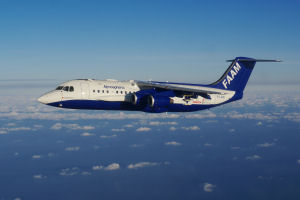Centre for Atmospheric Science contribution to Facility for Airborne Atmospheric Measurements (FAAM)
What is FAAM?
FAAM is a world-class research facility dedicated to the advancement of atmospheric science, funded by the Natural Environment Research Council and managed by the National Centre for Atmospheric Science.
FAAM operates a specially adapted research aircraft managed by a unique team of scientists, engineers, flight technicians and project managers providing a complete package of support of the UK atmospheric science community.
The aircraft can be configured to measure most atmospheric parameters, and is capable of advanced remote sensing, cloud microphysics and measuring complex chemical species in the atmosphere.
Discover the aircraft’s full capabilities on the FAAM website.
Instrumentation provided by the Centre for Atmospheric Science
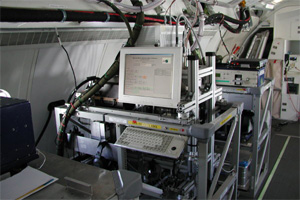
The Centre for Atmospheric Science currently provides two instrument racks inside the aircraft, and a number of externally mounted probes. Some of these were provided as part of the original JIF award, and in some cases have subsequently been upgraded. Others have been provided via funding from other sources. These instruments are listed in the following table along with a brief description of the measurements made by each one. More detailed information can be found by following the link to a full instrument description elsewhere on our website. It should be noted that we cannot fly the SP2 or UHSAS at the same time as ADA as these occupy the same space in the rack.
| Instrument | Measurements | FGAM? |
| Time of Flight Aerosol Mass Spectrometer | Non refractory size resolved aerosol chemical composition, 20-1000nm, including single particle composition. | Yes |
| Water based Condensation Particle Counter with Differential Mobility Analyser | Either 10Hz Total aerosol number 2-1000nm, or 5min average aerosol size distribution 10-500nm. | No |
| Single Particle Soot Photometer | Single particle soot mass, aerosol size distribution and fractional soot content ~200-900nm. | No |
| Ultra High Sensitivity Aerosol Spectrometer | 10Hz high resolution aerosol size distribution 50-800nm. | No |
| Cloud Particle Imager v1.5 | Single particle cloud particle habit classification sizing and number concentration. 1 Megapixel CCD array 2.3um pixel resolution. Particle size range 10-1500um approx. | Yes |
| Airborne Droplet Analyser | Single particle size and velocity for spherical particles only, subset of 1-100um size range. | Yes |
| SPEC 2D-128 Shadow Probe | Single particle cloud particle habit classification sizing and number concentration. 128 element linear high speed photodiode array 10um pixel resolution. Particle size range 10-1300um approx. | No |
| DMT Greyscale Cloud Aerosol and Precipitation Spectrometer | Single particle cloud particle habit classification sizing and number concentration 25-2500um. Aerosol/Cloud size distribution 0.5-30um. Liquid water content (hot wire). True air speed (pitot tube). | No |
| Cloud Droplet Probe | 10Hz Cloud particle size distribution 2-60um. Engineering test installation – location on fuselage is not suitable for measurements of particles larger than 20um. | No |
| Compact Cascade Impactor | 6 stage impactor for collection of aerosol in 100-5000nm size range for post-flight analysis. | No |
| Low Turbulence Inlet | Inlet designed to bring aerosol sample into aircraft cabin with no losses (sub micron) and known size dependant enhancement (super micron). | Yes |
| Chemical Ionisation Mass Spectrometer (CIMS) | Fast response Ammonia measurements (other species also possible) | No |
| Quantum Cascade Laser Absorbtion Spectrometer (QC-LAS) | Fast response (0.5Hz) Methane measurements. | No |
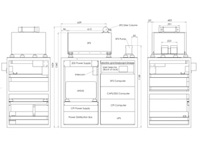
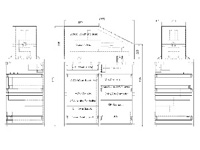
1. Layout of the cloud particle imager rack in aerosol configuration, which includes the following instruments – CPI, CAPS, 2D-128, SP2 and UHSAS.
2. Layout of the cloud particle imager rack in cloud configuration, which includes the following instruments – CPI, CAPS, 2D-128 and ADA.
Click on the image to view a high resolution version.
Note rack mounted aerosol instruments may sample from either the Low Turbulence Inlet, a Rosemount Inlet (sub micron only), or the Met Office Counterflow Virtual Impactor (cloud particle residuals). Each rack incorporates an actuated valve system to automatically or manually swap between two of these inlets during flight.
A considerable amount of effort has been put into designing the instrument racks and producing the required documentation to get the instrumentation certified to fly on this passenger aircraft. Additionally development work has been undertaken to overcome some of the unique challenges associated with operating some of these instruments on an airborne platform.
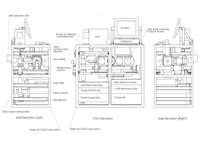
While these instruments are not currently provided as FAAM core instruments, the Centre for Atmospheric Science is happy to collaborate on projects using the aircraft which would benefit from these measurements. Such collaboration should be discussed with staff from the centre before a proposal is submitted to ensure that operation costs are included in the proposal. Additionally scheduling issues need to be taken into account as some instruments may also be needed for ground based projects. For those instruments which as part of FGAM this should be requested as per the instructions on the FGAM web pages.
